
Dinosaurs are a diverse group of reptiles of the clade Dinosauria. They first appeared during the Triassic period, between 243 and 233.23 million years ago (mya), although the exact origin and timing of the evolution of dinosaurs is a subject of active research. They became the dominant terrestrial vertebrates after the Triassic–Jurassic extinction event 201.3 mya and their dominance continued throughout the Jurassic and Cretaceous periods. The fossil record shows that birds are feathered dinosaurs, having evolved from earlier theropods during the Late Jurassic epoch, and are the only dinosaur lineage known to have survived the Cretaceous–Paleogene extinction event approximately 66 mya. Dinosaurs can therefore be divided into avian dinosaurs—birds—and the extinct non-avian dinosaurs, which are all dinosaurs other than birds.

Caudipteryx is a genus of small oviraptorosaur dinosaurs that lived in Asia during the Early Cretaceous, around 124.6 million years ago. They were feathered and extremely birdlike in their overall appearance, to the point that some paleontologists suggested it was a bird. Two species have been described: C. zoui, in 1998, and C. dongi, in 2000.

A scute or scutum is a bony external plate or scale overlaid with horn, as on the shell of a turtle, the skin of crocodilians, and the feet of birds. The term is also used to describe the anterior portion of the mesonotum in insects as well as some arachnids.

A feathered dinosaur is any species of dinosaur possessing feathers. That includes all species of birds, and in recent decades evidence has accumulated that many non-avian dinosaur species also possessed feathers in some shape or form. The extent to which feathers or feather-like structures were present in dinosaurs as a whole is a subject of ongoing debate and research.

Avimimus, meaning "bird mimic", is a genus of oviraptorosaurian theropod dinosaur, named for its bird-like characteristics, that lived in the late Cretaceous in what is now Mongolia, around 85 to 70 million years ago.

Avisaurus is a genus of enantiornithine bird from the Late Cretaceous of North America.

Elopteryx is a genus of, perhaps troodontid, maniraptoran theropod dinosaur based on fragmentary fossils found in late Cretaceous Period rocks of Romania. The single species, Elopteryx nopcsai, is known only from very incomplete material, and therefore is considered a nomen dubium by most paleontologists.
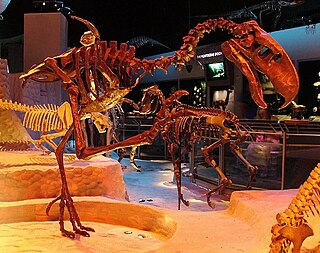
Titanis is a genus of phorusrhacid, an extinct family of large, predatory birds, in the order Cariamiformes that inhabited the United States during the Pliocene and earliest Pleistocene. The first fossils were unearthed by amateur archaeologists Benjamin Waller and Robert Allen from the Santa Fe River in Florida and were named Titanis walleri by ornithologist Pierce Brodkorb in 1963, the species name honoring Waller. The holotype material is fragmentary, consisting of only an incomplete right tarsometatarsus and phalanx, but comes from one of the largest phorusrhacid individuals known. In the years following the description, many more isolated elements have been unearthed from sites from other areas of Florida, Texas, and California. It was classified in the subfamily Phorusrhacinae, which includes some of the last and largest phorusrhacids like Devincenzia and Kelenken.

The scientific question of within which larger group of animals birds evolved has traditionally been called the "origin of birds". The present scientific consensus is that birds are a group of maniraptoran theropod dinosaurs that originated during the Mesozoic Era.

Yungavolucris is a genus of enantiornithean birds. It contains the single species Yungavolucris brevipedalis, which lived in the Late Cretaceous. The fossil bones were found in the Lecho Formation at estancia El Brete, Argentina."Yungavolucris brevipedalis" means "Short-footed Yungas bird". The generic name, Yungavolucris is after the Yungas region + the Latin volucris, which translates to "bird". The specific name brevipedalis is from the Latin brevis, which means "short", + pedalis, from the Latin pes, meaning "foot".
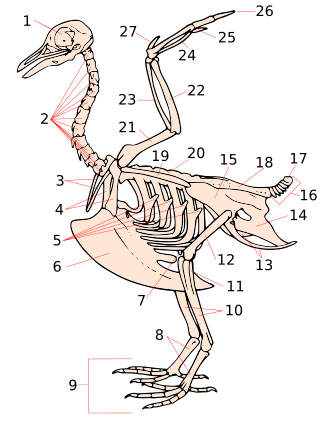
The tarsometatarsus is a bone that is only found in the lower leg of birds and some non-avian dinosaurs. It is formed from the fusion of several bones found in other types of animals, and homologous to the mammalian tarsus and metatarsal bones (foot). Despite this, the tarsometatarsus of birds is often referred to as just the shank, tarsus or metatarsus.
Neuquenornis volans is a species of enantiornithean birds which lived during the late Cretaceous period in today's Patagonia, Argentina. It is the only known species of the genus Neuquenornis. Its fossils were found in the Santonian Bajo de la Carpa Formation, dating from about 85-83 million years ago. This was a sizeable bird for its time, with a tarsometatarsus 46.8mm long. Informal estimates suggest that it measured nearly 30 cm (12 in) in length excluding the tail.
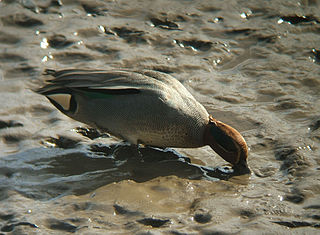
Bird ichnology is the study of avian life traces in ornithology and paleontology. Such life traces can include footprints, nests, feces and coproliths. Scientists gain insight about the behavior and diversity of birds by studying such evidence.

Avisauridae is a family of extinct enantiornithine dinosaurs from the Cretaceous period, distinguished by several features of their ankle bones. Depending on the definition used, Avisauridae is either a broad and widespread group of advanced enantiornithines, or a small family within that group, restricted to species from the Late Cretaceous of North and South America.
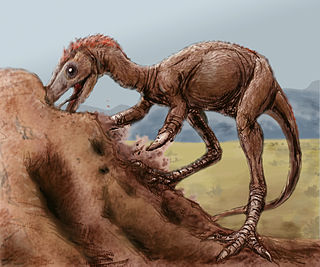
Kol is an extinct genus of coelurosaurian theropod dinosaur from the Late Cretaceous of Mongolia. The type and only species is Kol ghuva. The type specimen was excavated from the Ukhaa Tolgod locality of the Djadochta Formation, dating to about 75 million years ago. It is believed to have been about twice the size of the contemporaneous Shuvuuia. However, unlike Shuvuuia, which is known from many well preserved specimens, and although Ukhaa Tolgod has been thoroughly explored, Kol is known only from one complete foot, suggesting that it must have been relatively rare in that ecosystem.

Bauxitornis is an extinct genus of avisaurid enantiornithean birds which lived in what is now Hungary during the late Cretaceous period. Although first mentioned in a 2008 review of Hungarian Cretaceous bird fossils, it was named in a more comprehensive review by Gareth J. Dyke and Attila Ősi in 2010. The type species is Bauxitornis mindszentyae. The generic name "Bauxitornis" refers to the locality at which it was discovered, a Bauxite mine. The specific name "mindszentyae" honors Andrea Mindszenty, Ősi's advisor.

Philovenator is an extinct genus of troodontid paravian dinosaurs from the Wulansuhai Formation of Inner Mongolia, China. Its specific name honors Phillip J. Currie.

Yevgeny Nikolayevich Kurochkin was a Russian paleornithologist at the Paleontological Institute of the Russian Academy of Sciences. He served as President of the Menzbier Ornithological Society.
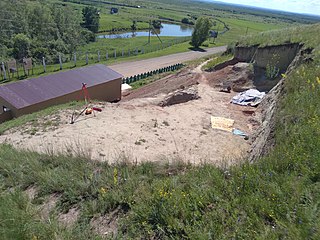
The Ilek Formation is a Lower Cretaceous geologic formation in Western Siberia. Many different fossils have been recovered from the formation. It overlies the Late Jurassic Tyazhin Formation and underlies the Albian Kiya Formation.
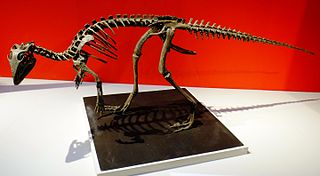
Kulindadromeus was a herbivorous dinosaur, a basal neornithischian from the Middle Jurassic. The first Kulindadromeus fossil was found in Russia. Its feather-like integument is evidence for protofeathers being basal to Ornithischia and possibly Dinosauria as a whole, rather than just to Coelurosauria, as previously suspected.





















